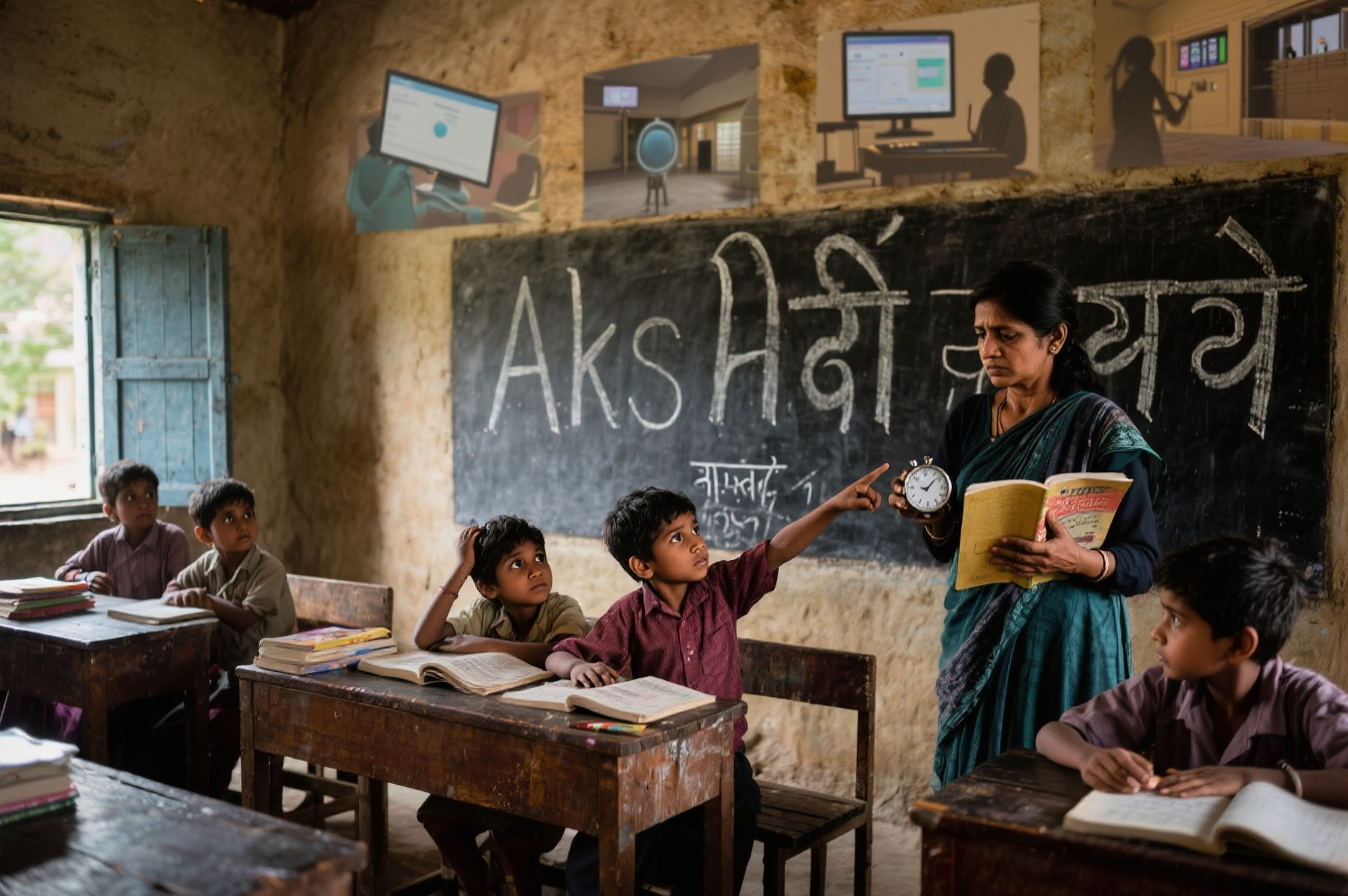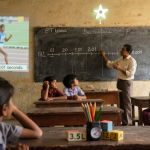- December 6, 2023
- by Educational Initiatives
- Blog
- 0 Comments
In the last two years, school education has been impacted worldwide. Although, learning was not ceased despite schools being shut; the percentage of children living in learning poverty has risen. Despite schools and teachers working hard to maintain full learning continuity through different mediums like online classes, WhatsApp, TV or phone, the ineffectiveness of remote learning is totally discernible. To top it all, many children in early years have been promoted to the next grade without being in a classroom even once. Is this promotion befitting? Have these children developmentally reached that stage? Do there learning levels match their grades? The answer, alas, is no.

As is well-known, any insufficiency in early years can lead to major limitations in future. Mainly, children who do not learn to read by Grade 3, fall behind. They find it challenging to understand other subjects and difficult to cope later due to the curriculum becoming more complex. To understand children’s reading level, we undertook a study in which we assessed 252 students speaking Hindi studying in grade 2 and grade 3 in Government school in Haryana. The assessment was done using pen and paper on a one-on-one basis. To do a deep-dive, let us pick one key task – letter recognition – as representative of the study which is the first step in learning how to read and a strong predictor of later reading success.
Tool
The letter recognition task was divided into two parts.
- Letter recognition accuracy: Students were shown same set of 15 aksharas (letters) in each grade which they had to identify one by one. The spread of the aksharas were different. The objective of this task was to check if the students can identify the aksharas accurately. The aksharas were a mix of with and without swarachinhas (abbreviated vowel signs) and high and low frequencies.
- Letter recognition fluency: Students were shown same set of 100 aksharas in each grade which they had to identify one by one in a minute. The objective of this task was to check if the students can identify the aksharas fluently. The aksharas were a mix of with and without swarachinhas and high and low frequencies.
To attain mastery in letter knowledge, both correct and fast identification is required. Hence, the task was divided into accuracy and fluency.
Result
Nag (2007) has elucidated that students in Grades 4 and 5 continue to learn alphasyllabic scripts. This is evident in our data too. In both the grades, moolaksharas (basic letters) are the most recognized letters while sanyuktakshara (conjoined consonants) and akshara with matras (abbreviated vowel signs) are the least recognized letters (Table 1).
| Grade | Least identified letters | Most identified letters |
| 2 | त्र क्ष वु मे | स आ उ ख |
| 3 | क्ष ज्ञ त्र वु | स उ ह आ |
Table 1: The table shows the least and highest identified letters in both the grades.
Figure 1 shows the average of accuracy of students in Grades 2 and 3. 63% of the students in Grade 2 and 86% in Grade 3 were able to identify the letters correctly. Though the average of accuracy has exponentially risen from grade 2 to grade 3, the fact that low frequency letters remain a challenge is alarming. This indicates that children are not provided sufficient time to practice and gain mastery over recognition of all the letters.
 Figure 1: Performance of students in letter recognition accuracy task.
Figure 1: Performance of students in letter recognition accuracy task.
Worryingly, 19% of the students in Grade 2 and 6.3% in Grade 3 were not able to identify even a single letter. It is worthwhile to note that 27% of the students in Grade 3 were able to accurately identify all the 15 letters.
 Figure 2: Percentage of students who scored 0 and 100% in letter accuracy task.
Figure 2: Percentage of students who scored 0 and 100% in letter accuracy task.
Figure 3 shows that children struggled in letter recognition fluency task. Letter fluency is measured in counts per minute, so on an average Grade 2 students were able to correctly recognise 31.5 letters in one minute which increased to 51.1 letters in Grade 3. It is said that Grade 1 should be able to recognise 60 letters in English in 1 minute.
 Figure 3 Performance of students in letter fluency task which is measured in counts per minute (cpm).
Figure 3 Performance of students in letter fluency task which is measured in counts per minute (cpm).
The low scores in fluency tasks can also be attributed to the teacher’s lack of efficiency and knowledge about the importance of fluency. Also, with low accuracy and fluency percentage, expecting students to learn to read by the end of Grade 3 so that they can then read to learn (NIPUN Bharat) seems dubious.
Discussion
From the results, we may interpret that accuracy is given more importance than the pace at which letters are being identified. Impairment in letter fluency causes struggle in decoding skills as children do not have freed up working memory to use to decode words. Their working memory is used to identify the individual sounds/letters in the word instead of blending the sounds to pronounce the word. Until mastery in fluency is attained, students will always struggle with the cognitive load to identify and blend letters/sounds over automatically (from their memory) reading the word.
Additionally, the sequential curriculum, generally, advances to reading passages in Grade 2. With limited or impaired akshara knowledge, students are likely to find it highly tough to read and understand grade level passages. Shall we re-align our curriculum to akshara knowledge in grade 1 or shall we have reading passages in grade 3?
More Evidence
In December 2021, when the schools reopened, we planned to visit some government schools in Lucknow. While interacting with the students, we found that grade 1 and 2 children were not even able to identify all the letters in Hindi accurately, leave aside reading words or reading to understand. This is in cognisance with the result we found from the data we received from students in Haryana. This left us jittery and disheartened. The impact of school closure, children being on their own and parents not knowing how to keep their child’s learning advancing has unquestionably hindered the children’s learning levels.
Conclusion
To sum up, I would like to quote Jamie Saavedra, World Bank Global Director for Education, “The loss of learning that many children are experiencing is morally unacceptable. And the potential increase of Learning Poverty might have a devastating impact on future productivity, earnings, and well-being for this generation of children and youth, their families, and the world’s economies.” The learning crisis requires immediate attention to safeguard and prevent jeopardising the future of many families.
In early years, enormous attention should be given on developing students’ reading skills. Developing mastery over akshara knowledge should be the starting point with more emphasis given on learning and practicing sanyuktakshara, akshara with swarachinhas and jodakshara.
References
NIPUN Bharat, https://www.education.gov.in/sites/upload_files/mhrd/files/nipun_bharat_eng1.pdf
Nag, S. (2007). Early reading in Kannada: the pace of acquisition of orthographic knowledge and phonemic awareness. Journal of Research in Reading, 30 (1), 7-22. http://eli.tiss.edu/wp-content/uploads/2018/08/Nag-2007-JRIR_329.pdf
UNICEF. (2021, December 6). Learning losses from covid-19 could cost this generation of students close to $17 trillion in lifetime earnings. UNICEF. Retrieved March 28, 2022, from https://www.unicef.org/press-releases/learning-losses-covid-19-could-cost-generation-students-close-17-trillion-lifetime



